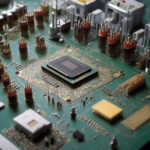Boeing Unveils 3D-Printed Solar Array Substrates That Cut Satellite Build Time by 50%
Aerospace giant Boeing has unveiled a new approach to solar array substrates that could dramatically revolutionize satellite manufacturing. By harnessing the power of 3D printing technology, Boeing has successfully created solar array substrates that have the potential to cut satellite build time in half. This groundbreaking innovation not only accelerates the production process but also significantly reduces costs, making it a game-changer in the aerospace industry.
Traditionally, the manufacturing of satellite components has been a time-consuming and labor-intensive process. However, with the introduction of 3D-printed solar array substrates, Boeing has streamlined production and increased efficiency. By utilizing additive manufacturing techniques, Boeing can now produce complex geometries and intricate designs with unparalleled precision, leading to faster assembly and integration processes.
One of the key advantages of 3D-printed solar array substrates is their lightweight yet durable nature. These substrates are designed to withstand the harsh conditions of space while maintaining structural integrity. By leveraging advanced materials and innovative design concepts, Boeing has created a product that not only meets the stringent requirements of satellite applications but also offers enhanced performance and reliability.
Moreover, the use of 3D printing technology enables Boeing to customize solar array substrates according to specific mission requirements. This level of flexibility and adaptability is unprecedented in the aerospace industry and opens up a world of possibilities for future satellite projects. Whether it’s optimizing power generation, improving efficiency, or enhancing overall mission success, the ability to tailor solar array substrates to meet individual needs is a significant advantage.
In addition to reducing build time and increasing customization options, 3D-printed solar array substrates also contribute to sustainability efforts. By minimizing material waste and energy consumption during the manufacturing process, Boeing is taking a step towards a more environmentally friendly approach to satellite production. This aligns with the growing demand for eco-conscious solutions in the aerospace sector and positions Boeing as a leader in sustainable innovation.
As we look towards the future of satellite technology, Boeing’s unveiling of 3D-printed solar array substrates marks a significant milestone in the industry. The combination of cutting-edge manufacturing techniques, enhanced performance capabilities, and environmental consciousness sets a new standard for satellite design and production. With the potential to revolutionize how satellites are built and deployed, this innovation paves the way for a new era of space exploration and connectivity.
In conclusion, Boeing’s 3D-printed solar array substrates represent a leap forward in satellite manufacturing, offering unprecedented efficiency, customization, and sustainability benefits. By harnessing the power of additive manufacturing, Boeing has not only reduced build time but also set a new standard for innovation in the aerospace industry. As we witness the impact of this groundbreaking technology, it is clear that the future of satellite design is brighter than ever before.
Boeing, 3D printing, Solar array substrates, Satellite technology, Aerospace innovation











